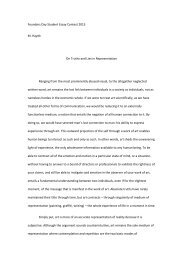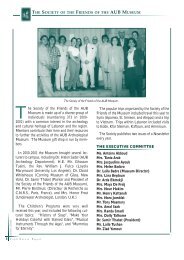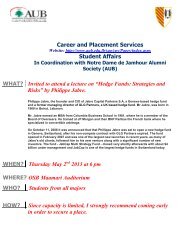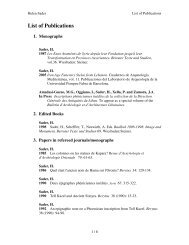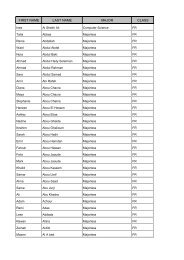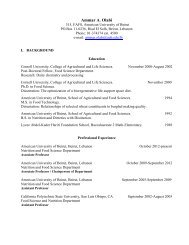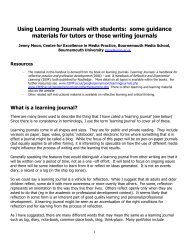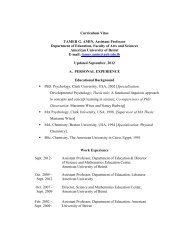The IX t h Makassed Medical Congress - American University of Beirut
The IX t h Makassed Medical Congress - American University of Beirut
The IX t h Makassed Medical Congress - American University of Beirut
You also want an ePaper? Increase the reach of your titles
YUMPU automatically turns print PDFs into web optimized ePapers that Google loves.
T h e I X t h M a k a s e d M e d i c a l C o n g r e s s<br />
clinical symptoms. D-penicillamine is a chelating agent, and remains the first line treatment <strong>of</strong><br />
WD. Treatement should be increased progressively and tolerance carefully monitored since<br />
many side effects have been reported (including early sensitivity reactions, nephrotoxicity,<br />
lupus-like syndrome, thrombocytopenia or total aplasia, dermatological manifestations. Trientine<br />
(triethylene tetramine dihydrochloride) is also a chelator effective in the treatment for WD and<br />
is indicated especially in patients who are intolerant <strong>of</strong> penicillamine. Trientine has few side<br />
effects. Zinc interferes with the uptake <strong>of</strong> copper from the gastrointestinal tract. Zinc has very<br />
few side effects. Although zinc is currently reserved for maintenance treatment, it has been<br />
used as first-line therapy, most commonly for asymptomatic or presymptomatic patients where it<br />
appears to be equally effective as penicillamine but much better tolerated. Foods with very high<br />
concentrations <strong>of</strong> copper (shellfish, nuts, chocolate, mushrooms, and organ meats) generally<br />
should be avoided, at least in the first year <strong>of</strong> treatment.<br />
Children with acute liver failure due to WD require liver transplantation, which is life-saving. A<br />
scoring system help determine which patients with acute hepatic presentations will not survive<br />
without liver transplantation, including serum bilirubin, serum aspartate aminotransferse, and<br />
prolongation <strong>of</strong> prothrombin time above normal. Until transplantation can be performed,<br />
plasmapheresis and hem<strong>of</strong>iltration and exchange transfusion or hem<strong>of</strong>iltration or dialysis may<br />
protect the kidneys from copper-mediated tubular damage. Albumin dialysis and Molecular<br />
Adsorbents Recirculating System ultrafiltration device can stabilize patients with acute liver failure<br />
due to WD and delay, but not eliminate, the need for transplantation.[<br />
RECENT ADVANCES AND PERSPECTIVES:<br />
Neurologic manifestations present most <strong>of</strong>ten in the third decade <strong>of</strong> life, but earlier subtle<br />
findings may appear in pediatric patients, including changes in behavior, deterioration in<br />
schoolwork, or inability to perform activities requiring good hand-eye coordination. Recent<br />
recommendations highlight the need <strong>of</strong> systematic neurological evaluation in childhood<br />
including eventually brain imaging procedure (computerized tomography and/or resonance<br />
magnetic imaging).<br />
Direct assessment <strong>of</strong> serum non-ceruloplasmin bound copper concentration is a promising tool<br />
both for diagnosis and monitoring treatment <strong>of</strong> WD.<br />
Non invasive tests for assessing liver fibrosis (fibrotest, fibroscan…) are promising tools to monitor<br />
evolution <strong>of</strong> liver disease.<br />
ACTUAL RECOMMENDATIONS (Diagnosis and treatment <strong>of</strong> Wilson disease: An update. AASLD<br />
Practice Guidelines. Eve A. Roberts, Michael L. Schilsky. Hepatology 2008;47:2089-111)<br />
1. WD should be considered in any individual between the ages <strong>of</strong> 3 and 55 years with liver<br />
abnormalities <strong>of</strong> uncertain cause. Age alone should not be the basis for eliminating a diagnosis<br />
<strong>of</strong> WD (Class I, Level B).<br />
2. WD must be excluded in any patient with unexplained liver disease along with neurological<br />
or neuropsychiatric disorder (Class I, Level B).<br />
3. In a patient in whom WD is suspected, Kayser-Fleischer rings should be sought by slit-lamp<br />
examination by a skilled examiner. <strong>The</strong> absence <strong>of</strong> Kayser-Fleischer rings does not exclude the<br />
diagnosis <strong>of</strong> WD, even in patients with predominantly neurological disease (Class I, Level B).<br />
4. An extremely low serum ceruloplasmin level (






